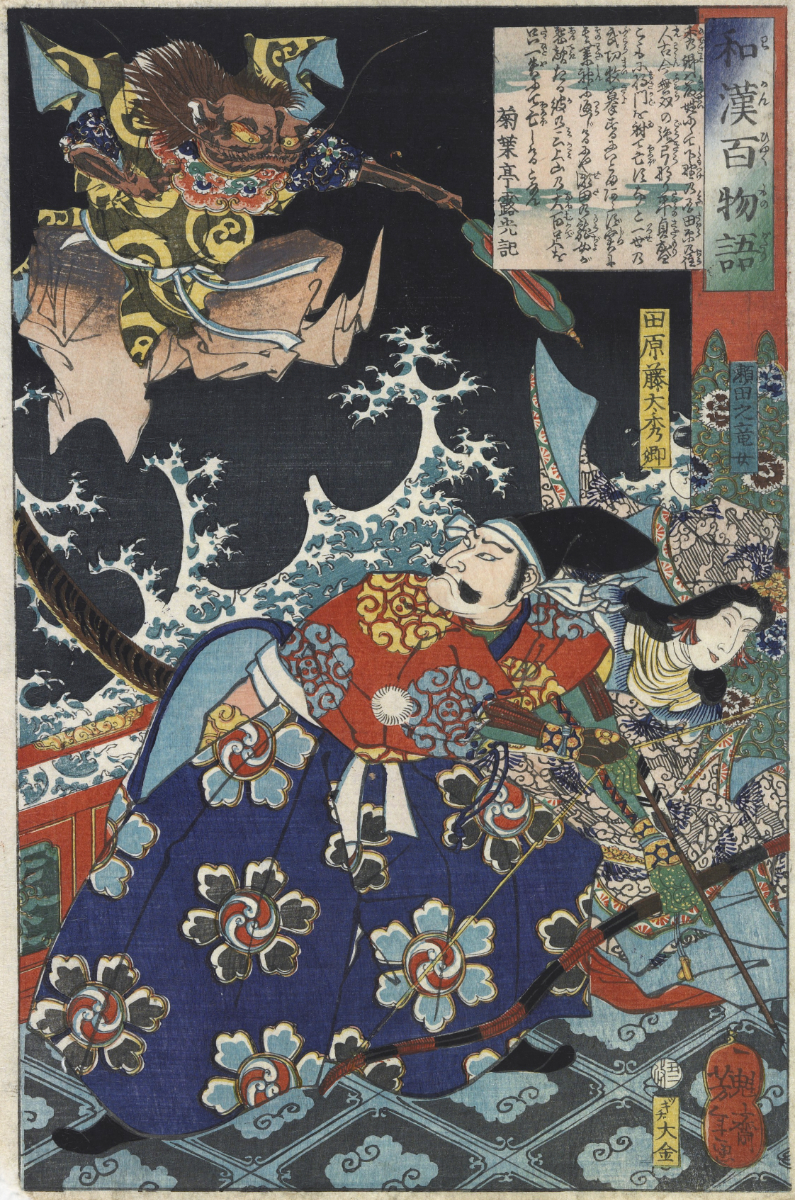Fujiwara no Hidesato was a Japanese aristocrat, courtier, folk hero and samurai lord of the tenth century in the Heian period. He is famous for his military exploits and courage, and is regarded as the common ancestor of numerous clans, including the Ōshū branch of the Fujiwara clan. Hidesato served under Emperor Suzaku, and fought alongside Taira no Sadamori in 940 in suppressing the revolt of Taira no Masakado. His prayer for victory before this battle is commemorated in the Kachiya Festival. Hidesato was then appointed Chinjufu shōgun (Defender of the North) and Governor of Shimotsuke Province. According to legend, he slew a giant centipede in Ōmi Province that plagued the Dragon Palace (above). Hidesato, also known by the moniker Tawara Tōda or Tawara no Tōta, is known in legend for his exploit of slaying the giant centipede (mukade) of Mount Mikami. Hidesato was recruited to this task by a giant dragon-snake which was, in fact, a resident of the Ryūgū-jō (Dragon Palace). Hidesato meets the Dragon King and is showered with rewards, which included an inexhaustible rice-sack (tawara [ja]), from which he allegedly earned his nickname. This centipede story, The Tale of Tawara Tōda, together with a romanticized account of his Masakado expedition comprise the Tawara Tōda Monogatari. The monogatari texts have been copied and printed profusely in picture scrolls and illustrated books throughout the Edo Period.
| Alias Fujiwara no Hidesato (藤原 秀郷) |
| Real Names/Alt Names Lord Bag-o’-Rice (nickname); Alt: Tawara Tōda, Tawara no Tōta, Tawara Tota Hidesato |
| Characteristics Samurai, Myths & Legends, Yōkai, Medieval Age, Japanese |
| Creators/Key Contributors Tsukioka Yoshitoshi |
| First Appearance Japanese folklore |
| First Publisher ○ |
| Appearance List Taiheiki (太平記, 14th c.), recounting 10th-century exploits of Tawara Tōda, My Lord Bag-o’-Rice. |
| Sample Read My Lord Bag-o’-Rice [Internet Archive] |
| Description Fujiwara no Hidesato was a Japanese aristocrat, courtier, folk hero and samurai lord of the tenth century in the Heian period. He is famous for his military exploits and courage, and is regarded as the common ancestor of numerous clans, including the Ōshū branch of the Fujiwara clan. Hidesato served under Emperor Suzaku, and fought alongside Taira no Sadamori in 940 in suppressing the revolt of Taira no Masakado. His prayer for victory before this battle is commemorated in the Kachiya Festival. Hidesato was then appointed Chinjufu shōgun (Defender of the North) and Governor of Shimotsuke Province. According to legend, he slew a giant centipede in Ōmi Province that plagued the Dragon Palace (above). Hidesato, also known by the moniker Tawara Tōda or Tawara no Tōta, is known in legend for his exploit of slaying the giant centipede (mukade) of Mount Mikami. Hidesato was recruited to this task by a giant dragon-snake which was, in fact, a resident of the Ryūgū-jō (Dragon Palace). Hidesato meets the Dragon King and is showered with rewards, which included an inexhaustible rice-sack (tawara [ja]), from which he allegedly earned his nickname. This centipede story, The Tale of Tawara Tōda, together with a romanticized account of his Masakado expedition comprise the Tawara Tōda Monogatari. The monogatari texts have been copied and printed profusely in picture scrolls and illustrated books throughout the Edo Period. |
| Source Fujiwara no Hidesato – Wikipedia |


